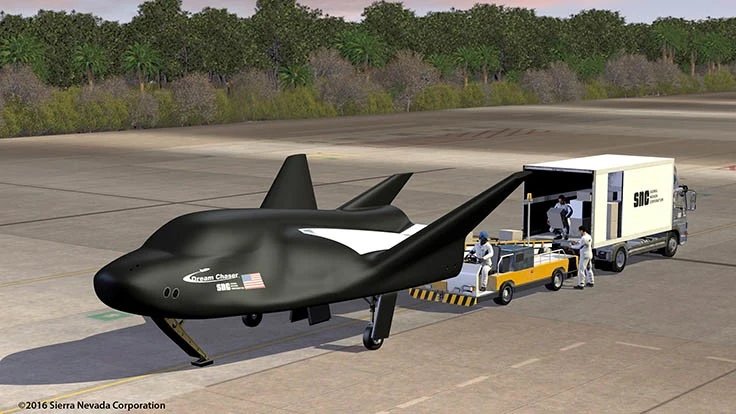
Sierra Nevada Corp.
Sierra Nevada Corp.’s (SNC) Dream Chaser spacecraft passed a key milestone for NASA’S Commercial Resupply Services 2 (CRS-2) contract, validating design performance and clearing the way for full spacecraft production. The milestone marks completion of Integration Review 4 (IR4) demonstrating NASA’s confidence in the safety and maturity of Dream Chaser’s design.
"NASA's acknowledgement that SNC has completed this critical milestone and its approval of full production of the first Dream Chaser spacecraft is a major indication we are on the right path toward increasing vital science return for the industry," said John Curry, program director for CRS-2 under SNC’s Space Systems business area.
Many critical parts of the orbital vehicle are already complete, built, and being tested, including major structural components, thermal protection system tiles, and avionics hardware. With the success of IR4, these components are now being integrated into the orbital vehicle assembly at SNC’s Space Systems facilities in Louisville, Colorado.
Subject matter experts from NASA and SNC thoroughly reviewed the Dream Chaser spacecraft design and its integrated performance with launch, ground, and flight elements. Based on system capabilities, design maturity, and the extensive data products presented, SNC and NASA jointly concluded the Dream Chaser program was ready to move to full-scale spacecraft manufacturing and testing.
SNC’s Dream Chaser spacecraft is slated to service the International Space Station as early as late 2020. Production includes both the uncrewed Dream Chaser winged vehicle and the cargo module, which remains attached to the winged vehicle during orbital operations.
“We are one step closer to the Dream Chaser spacecraft’s first orbital flight. This comprehensive review approved moving the Dream Chaser program into the production phase, so we can get Dream Chaser to market as a critical space station resupply spacecraft as soon as possible,” said Fatih Ozmen, co-owner and CEO of SNC. “IR4 was a series of reviews, documentation, and data deliverables that are the culmination of many years of design work, analysis, and development testing.”
The Dream Chaser will perform at least six missions to provide cargo resupply, disposal, and return services to the International Space Station under NASA’s CRS-2 contract. The spacecraft delivers up to 5,500kg (12,100 lb) of pressurized and unpressurized cargo and returns more than 1,850 kg (~4,000lbs) of cargo with a gentle runway landing. The spacecraft also provides approximately 3,400kg (7,400 lb) of disposal capability each mission via the cargo module, which burns up in the atmosphere after separation from the Dream Chaser winged vehicle.
NASA selected the Dream Chaser Cargo System to provide cargo delivery and disposal services to the space station under the Commercial Resupply Services 2 (CRS-2) contract. All Dream Chaser CRS-2 cargo missions are planned to land at Kennedy Space Center’s Shuttle Landing Facility.
Latest from Aerospace Manufacturing and Design
- Lockheed Martin, NASA X-59 takes flight
- Claw jaws for maximum clamping force
- #53 Lunch + Learn Podcast with Iscar
- PI moves into new US headquarters
- Indexable thread milling grade with PVD aluminum oxide coating
- Falcon Aviation Services orders 50 eVTOL aircraft from AutoFlight
- Finned rollers for firm, safe, efficient parts handling
- Vietjet finalizes order for 100 Airbus A321neo aircraft





